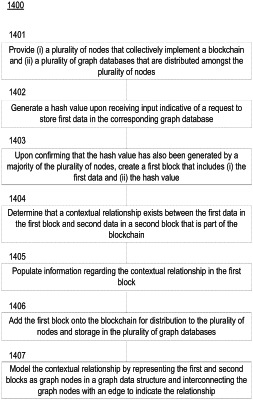| CPC H04L 9/50 (2022.05) [G06F 16/2379 (2019.01); G06F 16/27 (2019.01); G06F 16/9024 (2019.01); G16H 50/70 (2018.01); H04L 9/3236 (2013.01)] | 11 Claims |

|
1. A data storage platform comprising:
a plurality of nodes that collectively implement a blockchain; and
a plurality of graph databases that are distributed amongst the plurality of nodes,
wherein each of the plurality of graph databases includes a persistent store of data committed to the blockchain, and
wherein each of the plurality of graph databases is associated with a corresponding one of the plurality of nodes;
wherein each of the plurality of nodes includes a processor and associated memory with instructions stored therein that, when executed by the processor, implement:
a consensus trust module operable to:
upon receiving input indicative of a request from an individual to store data in the corresponding graph database,
generate a hash value that is representative of integrity of the data,
distribute the data, updated with the hash value, to the other nodes of the plurality of nodes, and
upon confirming that the hash value has also been generated by a majority of the plurality of nodes,
create a block that includes the data; and
a graph module operable to:
apply a trained algorithm to the blockchain to autonomously learn a relationship between the data in the block and other data in another block that is part of the blockchain,
populate information regarding the relationship in the block, so as to record the relationship with the another block, and
add the block onto the blockchain for distribution to the plurality of nodes and storage in the plurality of graph databases.
|